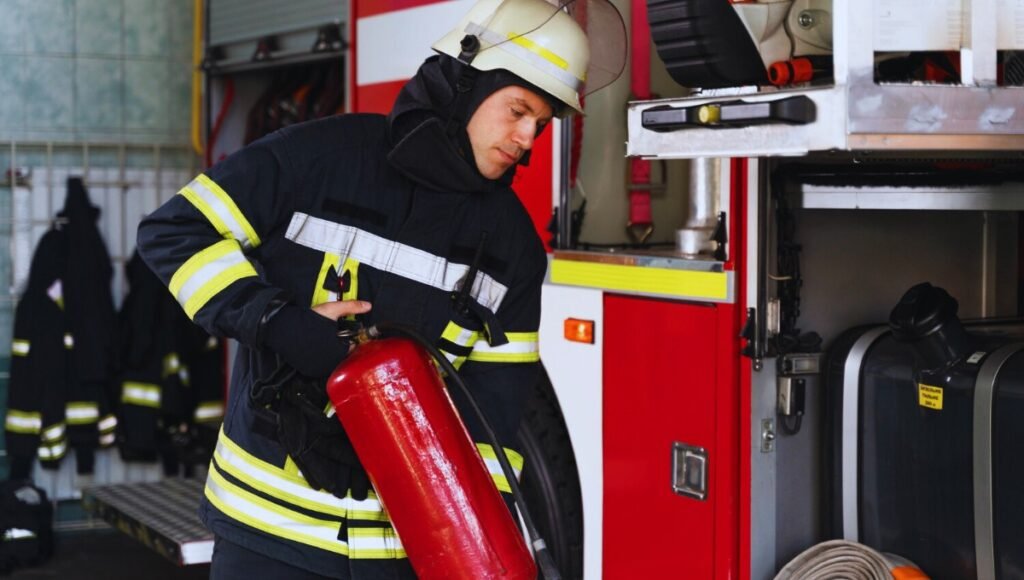Keeping Fire Extinguisher Maintenance in top condition is essential for safety. A well-maintained fire extinguisher can make the difference in an emergency, helping to control or even extinguish a fire before it gets out of hand. Regular inspection and servicing, including professional extinguisher maintenance in London, ensure that extinguishers function correctly when needed. In this blog, we will guide you through the process of inspecting and servicing your Fire Extinguisher Maintenance to keep them reliable and ready for action.
Table of Contents
Why Fire Extinguisher Maintenance is Important
Fire Extinguisher Maintenance are critical safety tools designed to suppress small fires before they escalate. However, like any piece of equipment, they can become less effective over time due to wear and tear or other issues. Regular maintenance is crucial to ensure that extinguishers work properly when needed. Without proper upkeep, an extinguisher may fail to discharge or might not operate correctly, potentially putting lives and property at risk.
Inspecting Your Fire Extinguisher Maintenance
In any guide to Fire Extinguisher Maintenance, routine inspections are crucial for ensuring their effectiveness. Conducting monthly inspections is essential to verify that each fire extinguisher remains in good working condition and is easily accessible when needed. Regular checks help identify any issues, such as pressure loss or damage, ensuring that the extinguishers will function properly in an emergency. Keeping up with these inspections is a vital part of your overall fire safety strategy.
Check the Pressure Gauge
One of the first things to inspect is the pressure gauge. The gauge indicates whether the extinguisher is charged and ready for use. It should be in the green zone, indicating that the extinguisher is properly pressurized. If the needle is in the red zone, it means the extinguisher is either overcharged or undercharged, which could affect its performance.
Examine the Physical Condition
Inspect the extinguisher for any visible signs of damage. Look for dents, cracks, or corrosion on the cylinder. The hose and nozzle should be intact and free of blockages. Any damage to the extinguisher’s physical condition can compromise its effectiveness.
Check the Safety Seal
The safety seal or tamper indicator ensures that the extinguisher has not been used or tampered with. Ensure that the seal is intact and unbroken. A missing or broken seal could indicate that the extinguisher may have been used or tampered with, which means it might not be reliable.
Verify Accessibility
Ensure that the fire extinguisher is placed in a location that is easily accessible. It should be mounted on a wall or in a designated spot that is clearly marked and unobstructed. Fire Extinguisher Maintenance should be kept in locations where they can be quickly retrieved in an emergency.
Servicing Your Fire Extinguisher Maintenance
In addition to monthly inspections, Fire Extinguisher Maintenance require annual servicing by a professional. This servicing includes a thorough examination and maintenance of the extinguisher to ensure it meets safety standards.
Professional Inspections
A qualified technician should perform a detailed inspection of your Fire Extinguisher Maintenance at least once a year. This inspection includes checking the extinguisher’s overall condition, pressure levels, and functionality. The technician will also test the extinguisher to ensure it is capable of operating effectively.
Recharging
If an extinguisher has been used, even partially, it needs to be recharged. During servicing, the technician will refill the extinguisher with the appropriate extinguishing agent and ensure it is pressurized correctly. This is crucial because a partially used extinguisher will not provide adequate protection in the event of a fire.
Hydrostatic Testing
Hydrostatic testing is a process where the extinguisher’s cylinder is subjected to high pressure to ensure it can withstand the stress of being used. This testing is typically required every 5 to 12 years, depending on the type of extinguisher and manufacturer’s recommendations. The testing ensures that the cylinder is still safe to use and does not have any weaknesses that could lead to failure.
Replacing Parts
Any defective or worn-out parts, such as hoses or nozzles, should be replaced during the servicing. The technician will check these components and replace them if necessary to ensure that the extinguisher operates properly.
Conclusion
Maintaining your Fire Extinguisher Maintenance through regular inspections and professional servicing is crucial for ensuring they will function effectively in an emergency. By checking the pressure gauge, physical condition, safety seal, and accessibility of your extinguishers each month, and scheduling annual professional servicing, you can help ensure that your extinguishers are always ready to help protect lives and property.
Remember, proper maintenance not only keeps you compliant with safety regulations but also provides peace of mind knowing that you have a reliable first line of defense against fires. Regular care and attention to your Fire Extinguisher Maintenance can make all the difference in an emergency situation, If you want to stay updated with posts like this, please follow us on Henof.

